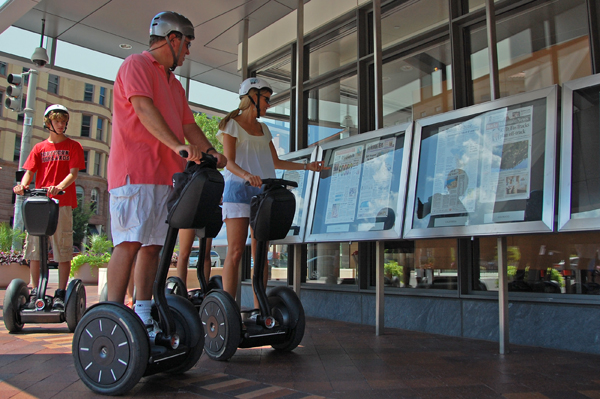
Segway-equipped tourists browse the daily front pages - one from each state - posted in front of the Newseum each morning.
I went to the Newseum's restroom, a place with shiny tiles on the walls that said things like "Asteroid Nearly Misses Earth." It was a newspaper headline likely botched by a copy editor who didn't know that "nearly misses" means it didn't miss. It was a second-day story about the end of the world.
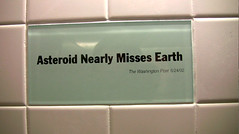 When someone outside the media realm asks me what I do, I say I'm a journalist. If I have time for a conversation, I say I'm an editor. If there are La-Z-Boys and coffee nearby, I sit down, take a gulp and explain what I really do as a copy editor.
When someone outside the media realm asks me what I do, I say I'm a journalist. If I have time for a conversation, I say I'm an editor. If there are La-Z-Boys and coffee nearby, I sit down, take a gulp and explain what I really do as a copy editor.Copy editors are superhuman. They're supposed to catch the asteroid before it hits Earth.
But because many people outside the world of newspapers don't understand what we do, I should ask: If copy editors ever go away, will anyone notice?
Lawrence Downes of The New York Times says no, as manifest in his trip to Washington's Newseum, a museum of news and journalism that lacks - by name, at least - a copy editing exhibit.
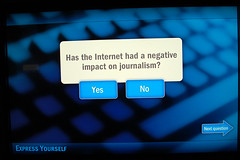 In June, he wrote "In a Changing World of News, an Elegy for Copy Editors," an editorial that stirred ire among "testy" copy editors. They felt slighted that their jobs are becoming less significant in the Internet's get-it-right-first, no-time-for-picky-editing news cycle. "Copy editors are being bought out or forced out; they are dying and not being replaced," he wrote. Because copy editing isn't represented at the Newseum, it's obviously being forgotten.
In June, he wrote "In a Changing World of News, an Elegy for Copy Editors," an editorial that stirred ire among "testy" copy editors. They felt slighted that their jobs are becoming less significant in the Internet's get-it-right-first, no-time-for-picky-editing news cycle. "Copy editors are being bought out or forced out; they are dying and not being replaced," he wrote. Because copy editing isn't represented at the Newseum, it's obviously being forgotten."I thanked Lawrence for making me feel completely hopeless," Phillip Blanchard, who worked at The Washington Post until he got bought out, said on his Web site, TestyCopyEditors.org.
Downes and I received some of the greatest training possible for copy editors. We both went through the Dow Jones Newspaper Fund's training program and were taught by Ed Trayes, a co-founder of the fund, at Temple University. We both interned at Newsday. We both know the value of copy editing, the phenomenon Downes says is taking its last breath.
"I’m still an editor at heart," he wrote in a post this week on Trayes' blog. "Editors - copy editors in particular - are underappreciated and overabused."
In just a year of full-time work as a copy editor, I could not agree more. We rarely get credit for our work unless we design a sterling newspaper page or write an award-winning headline. We toil when most people are sleeping. And it's the work that doesn't appear in the newspaper that is our best: stories we have spiked, sparing plagiarism from print; misspelled names we have changed, skirting an embarrassing correction; libel we have caught, avoiding millions in legal penalties; headlines we have tweaked, preventing the end of the world.
Like Downes, I went to the Newseum. But I saw something different.
 In each display - the 383 memorable front pages, the historic mistakes, the prize-winning stories - I saw something that reminded me of what I do every day. As I browsed, I thought: I could have improved that headline; I would not have made that error; there were copy editors behind that Pulitzer.
In each display - the 383 memorable front pages, the historic mistakes, the prize-winning stories - I saw something that reminded me of what I do every day. As I browsed, I thought: I could have improved that headline; I would not have made that error; there were copy editors behind that Pulitzer.But I was especially proud when I went to the restroom. On the wall were headlines - likely written by copy editors - that should have never been published: "Panda Lectures at Zoo" (always knew they were smart); "Woman Found Dead in Trunk Kept to Herself, Neighbors Say" (obviously); "Actor Sent to Jail for Not Finishing Sentence" (should happen to reporters, too); and, as mentioned, "Asteroid Nearly Misses Earth" (a New York Times story that the Daily News is undoubtedly mad that it overlooked). As do our triumphs, our screw-ups show our value.
But the fundamental issue is not whether a museum of news shows copy editors' part in history. It is not whether copy editors will matter in the future. The question all journalists - reporters, photographers, copy editors - should ask themselves is this: Are we all, because of our traditional beliefs, becoming extinct?
This "webby" focus and inability to "generate Google hits" with traditional methods - which Downes says are diminishing the copy editor's role - are doing the same to the reporter, the photographer and the editorial writer.
At most newspapers, copy editors don't have time to sit down and edit a story for an hour. But at all newspapers, most reporters don't have time to sit down and write a story for an hour. The Web has changed copy editors no more than it has changed reporters.
 The most interesting exhibit I saw in the Newseum foreshadows all journalists' futures. It was about social media, the ability of everyone - including the people who have never heard of a "copy editor" - to make and produce news and to disseminate their opinions.
The most interesting exhibit I saw in the Newseum foreshadows all journalists' futures. It was about social media, the ability of everyone - including the people who have never heard of a "copy editor" - to make and produce news and to disseminate their opinions.So if copy editors were wiped from the Earth, would anyone notice?
People noticed "Dewey Defeats Truman." They noticed Jayson Blair. They noticed New York Times v. Sullivan.
If Downes' death knell rings true for all newspaper journalists, not just copy editors, the Newseum will have to dedicate more than just a restroom to the historic blunders of news.
It will mean the end of the world every day.
__________
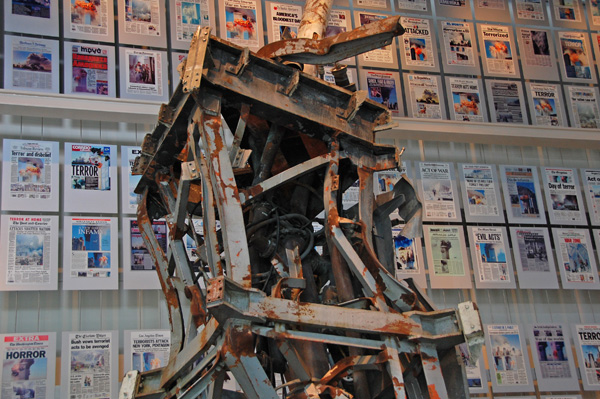
Copy editors touched each one of those pages from Sept. 12, 2001, behind the antenna mast from the North Tower of the World Trade Center.
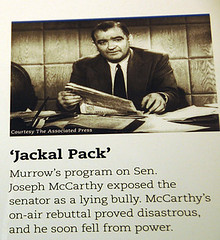
The Newseum could use a copy editor. The Edward R. Murrow exhibit gives the CBS broadcaster credit for exposing Joseph McCarthy as "a lying bully." Murrow wasn't even close to being the first one to attack McCarthy. He simply used newspapers to show the evidence against him. Far from groundbreaking.
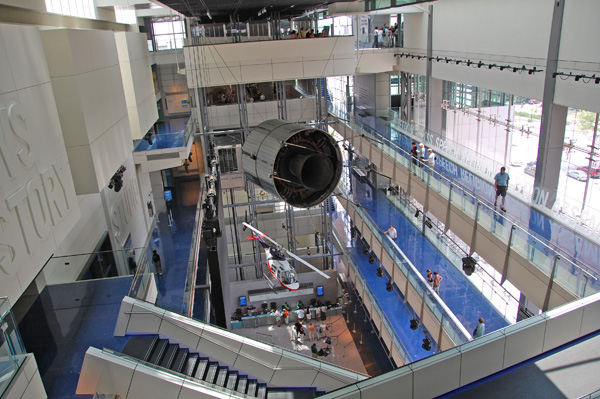
The heart of the Newseum features a replica of a communications satellite.
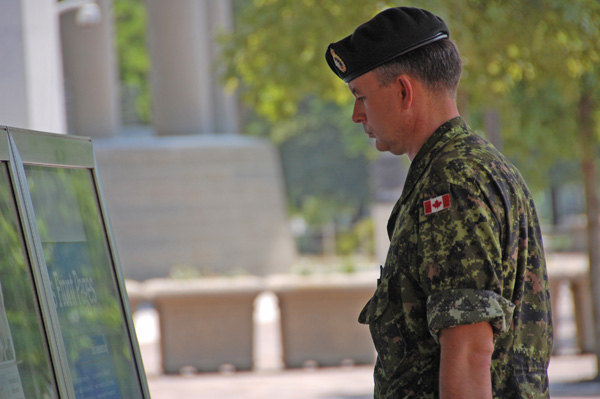
A Canadian soldier looks at the international section of the day's front pages in front of the Newseum. The Canadian Embassy is next door.
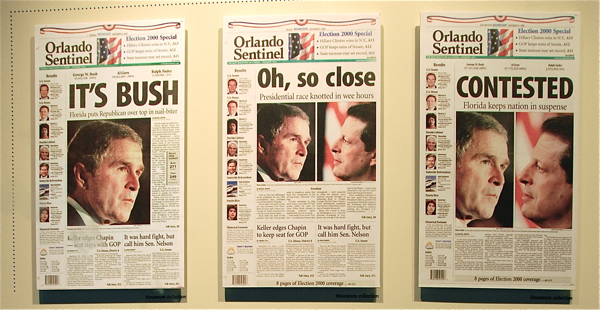
A trilogy of headlines all from the same night in 2000.
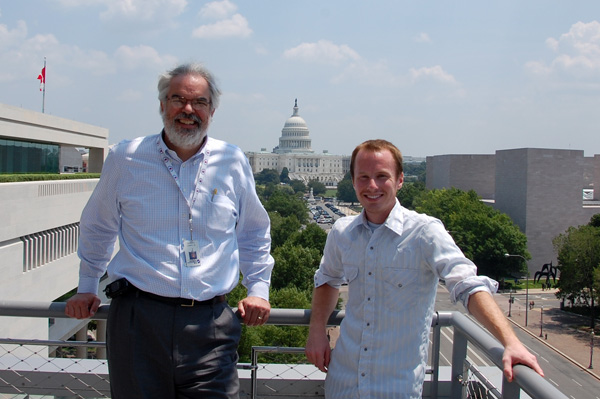
W. Joseph Campbell, a professor of mine, wrote most of the captions for the 383 historic front pages featured at the Newseum.



3 comments:
Just for the record, my comment to Lawrence was somewhat tongue-in-cheek. Lawrence and I worked together in Chicago, and we know and understand each other. I'm pretty sure he knows there's more to Testy Copy Editors than sniping at colleagues.
Absolutely. And I didn't mean to portray it that way either.
Great recap and photos. Thanks for posting.
Post a Comment